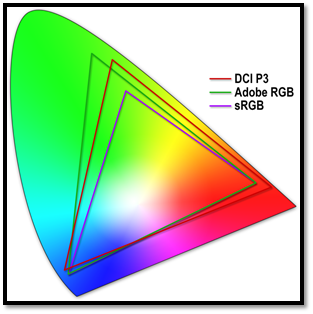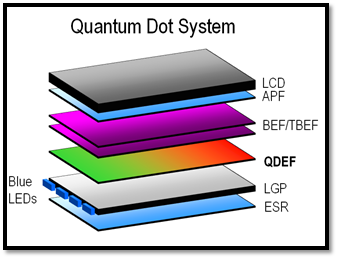In medieval times, artisans created magnificent windows of stained glass to communicate to the masses. The mechanism was simple: light from the sun shined through artfully arranged shards of brilliantly colored glass. Less simple was the science behind those colors. In fact, early color technologists were among the first to use nanotechnology: They mixed gold chloride into molten glass to form minuscule gold spheres, which would impart a dramatic red color to the sunlit glass.
Today, liquid crystal displays (LCDs) use a similar mechanism to communicate images and information. Light from an LED shines through bits of red, blue, and green plastic that make up the color filter. And nanotechnology will again soon be central to the creation of strikingly beautiful colors, including eye-popping reds that have rarely been seen on electronic displays.
Unlike their medieval predecessors, though, today’s technologists aren’t applying nanotechnology to the colored shards. Instead, they are using nano semiconductor structures called quantum dots to convert LED light from blue to white.
These minute dots — only 2 to 6 nm across — could have an enormous impact on the display industry. In just a few years, high-resolution screens went from exotic to desirable to a requirement; in the next few years, quantum dots will move high-gamut color along the same continuum. They will allow LCDs to offer competitive, and in some cases superior, color compared to the best commercial OLED displays currently available.
Reinvigorating LCD technology
LCDs are ubiquitous. Because they are reliable, adaptable, and inexpensive, they have become workhorses of the display industry.
This dominance has been contested by OLED displays. The first OLED demonstrations promised advantages in performance and form factor; LCDs have answered with improvements that approach or match almost anything the OLEDs can offer, while preserving LCDs’ advantages in cost, reliability, and consistent supply.
LCDs have been less successful in matching OLED color. With the exception of a few high-performance models, LCDs usually topped out at the sRGB color gamut, about 70% of the size of the color gamut that OLEDs commonly produce. That extra 30% is even more important than it sounds. A recent 3M pilot study found that the larger color gamut increased viewers’ attention by 50%.
With quantum dots, LCDs can now reach a color gamut that is essentially equivalent in size to that of an OLED display. The gamut for OLED displays remains a little larger in the green part of the spectrum. Quantum dots can offer LCDs significant improvements in green, allowing them to achieve the Adobe RGB gamut, and they excel in generating striking reds like those that are called for in the motion picture industry’s demanding DCI P3 standard (see Fig. 1 ).

Fig. 1: The Adobe RGB and DCI P3 standards are similar, although the Adobe RGB calls for more saturated greens and the DCI P3 has more saturated reds.
Hitting the peaks
In a typical LCD backlight unit (BLU), light is generated by white LEDs. The most common white LEDs start with blue light. To produce a full-spectrum white, the blue LEDs are coated with a yellow phosphor (usually yttrium aluminum garnet or YAG). The resulting light is a bright, daylight white consisting of the sharp spike from the blue LED and the broad yellow hump from the yellow phosphor.
A quantum dot-equipped backlight uses a similar approach. When exposed to the light emitted by a blue LED, quantum dots convert some of the light to green and some to red. When combined with the LED’s intrinsic blue light, the result is a white light with narrow peaks in the three primary colors.
Those primary peaks matter, because LCDs produce more saturated colors when exposed to a narrow spectrum light that aligns with the color filters than when they filter broadly distributed light. The red color filter, for example, transmits a band of wavelengths greater than 570 nm (a mix of yellow, orange, and red) and blocks the other wavelengths. When the backlight provides fewer of the non-primary, intermediate colors, the liquid crystal panel transmits a purer, more narrowly controlled red (see Fig. 2 ).

Fig. 2: When the light from a conventional “white” LED passes through a color filter, the greens and reds appear unsaturated. When light from a blue LED is converted by quantum dots instead of a yellow phosphor, it has concentrated peaks and colors are saturated.
Using quantum dots with highly efficient blue LEDs and conventional color filters, LCDs can express a high color gamut more efficiently than other high color-gamut approaches, which typically involve special (and more energy-intensive) LEDs, more aggressive color filters, or both. In some instances, a quantum-dot-equipped LCD can be as much as 50% more efficient than earlier high-color-gamut LCDs.
Little dots, big challenges
The spectral output of a quantum dot is determined by its chemical composition and—uniquely—by its size. When blue photons (around 450 nm) strike a very small dot—around 2.5 nm in diameter—the dot emits a saturated green light. When the same bluish light hits a larger, 6-nm diameter dot, it produces red.
Manufacturing the dots to such precise specifications is, obviously, an impressive technical achievement. Incorporating them into a device—which requires that the dots be protected from oxygen and moisture and distributed to create even color across the entire display—is equally demanding. One way to incorporate quantum dots into a display is Quantum Dot Enhancement Film (QDEF), a thin film with a precisely controlled layer of dots sandwiched between two sheets of barrier film.
Integrating QDEF technology into existing LCD manufacturing processes is much less challenging. The film can be used in lieu of the diffuser sheets that are typically positioned on top of the lightguide plate (see Fig. 3 ).

Fig. 3: Introducing QDEF is minimally disruptive to LCD manufacturing. The film can replace the diffuser in a conventional LCD backlight, while other components remain in place.
The BLU’s other components — such as the reflector, prism films, and reflective polarizer — remain in place. These extended gamuts will eventually become a virtual necessity for displays. Once we have been exposed to higher quality imagery, the older and lower quality images seem dull, antiquated and unappealing. There is a reason why there are no black-and-white windows in cathedrals: Once people had been exposed to the stunning colors of stained-glass artisans, there was no turning back. Medieval architects and artisans knew intuitively that we are moved by visual images and the brighter and more colorful those images are, the better they look; in short, the more profound our response.
Advertisement
Learn more about 3M





